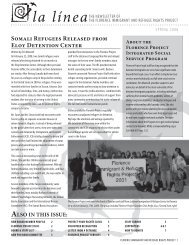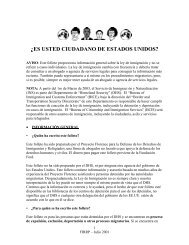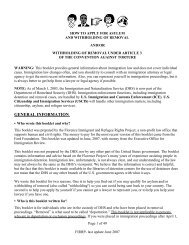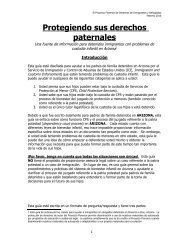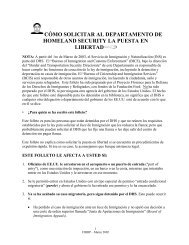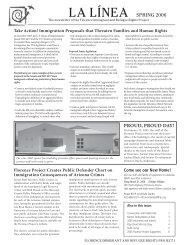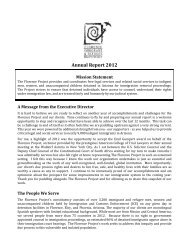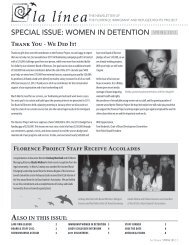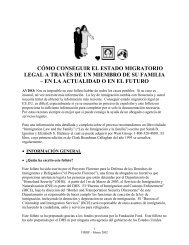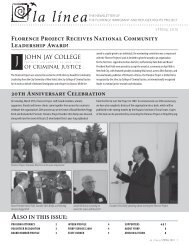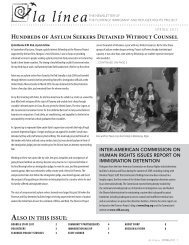La Linea - The Florence Project
La Linea - The Florence Project
La Linea - The Florence Project
Create successful ePaper yourself
Turn your PDF publications into a flip-book with our unique Google optimized e-Paper software.
<strong>La</strong> <strong>Linea</strong><strong>The</strong> Newsletter of the <strong>Florence</strong> Immigrant & Refugee Rights <strong>Project</strong>RELEASE FROM DETENTION:HIGHLIGHTSFROM FLORENCE, AZIn recent months, <strong>Florence</strong> <strong>Project</strong>staff has worked to win release fromdetention for four individuals whoseunusual cases were described as “the firstof their kind for the <strong>Project</strong>” by SuzannahMaclay, Senior Staff Attorney.OUR FIRST AND SECOND CASES involvedtwo North Koreans whose names cannotbe publicized because of the risk ofexposing their families in North Korea torepercussions. <strong>The</strong>se individuals’ quest forfreedom began when they defected fromNorth Korea into China. <strong>La</strong>ter, they wereforced by North Korean patrols to cross theborder into Russia, where they arrangedfor a smuggler to transport them to Mexicoand then into the United States. In SouthernArizona, near the Mexico border, they weretaken into custody by U.S. immigrationauthorities and placed in federal detentionin <strong>Florence</strong>. Thanks to translationassistance from an Arizona State UniversityKorean-language instructor, <strong>Florence</strong><strong>Project</strong> staff learned the details of thesefreedom-seekers’ flight from starvationand a notoriously repressive regime. <strong>The</strong>irstories of life in North Korea, along withSuzannah Maclay, Alejandra Arias Garcia and Parents- Photo by FIRRPnewly available documentation that wassubmitted as evidence at their hearing,established clearly that, if deported, thesetwo individuals would be imprisoned ininhumane conditions, severely tortured, andpossibly executed. <strong>The</strong> immigration judgegranted the North Koreans asylum, findingthat they had well-founded reasons to fearpersecution if returnedto their home country.Upon release, the twowere welcomed intothe thriving Koreancommunity in Phoenix.To the <strong>Florence</strong><strong>Project</strong>’s knowledge,their cases represent thefirst time in the UnitedStates that INS-detainedNorth Koreans havebeen granted asylum.THE THIRD CASEconcerned AlejandraArias Garcia, a 19-yearoldlegal permanent resident. AlthoughMs. Garcia has lived in the United Statessince infancy, federal laws had her facingpermanent deportation from the U.S. afterbeing convicted on misdemeanor charges.To fight the implementation of this extremedeportation measure, <strong>Florence</strong> <strong>Project</strong>staff coordinated with her family membersand friends, interestedcommunity groups, andlaw students to advocatefor her release. WashingtonSquare Legal Servicesof New York University,which representedCitizens and Immigrantsfor Equal Justice, lobbiedand protested for Ms.Garcia’s cause. Editorialsoutlining the absurdity ofher possible deportationappeared in localSpring 2003newspapers, including the ArizonaRepublic (Phoenix) and the Arizona DailyStar (Tucson). Ultimately, the <strong>Florence</strong><strong>Project</strong>’s network of supporters persuadedan Arizona state legislator, Ed Pastor, tointroduce private legislation in the U.S.House of Representatives, H.R. 393. Ms.Garcia is currently out of detention waitingReza Baluchi at the <strong>Florence</strong> Detention Center - Photo by , NY Timesfor the results of the legislation that willdetermine whether she will remain in theU.S. or not. Her case reveals how draconianU.S. immigration policy has become—andunderscores the need for prosecutorialand judicial discretion to allow reasonablerulings in cases like hers.THE FOURTH CASE involved Reza Baluchi,an Iranian who inadvertently crossed intothe United States from Mexico whiletraveling around the world by bicycle on acontinued on page 7 ...Also in this issue:A Child’s Visa StruggleINS Becomes BICEAn Interpreter’s ViewpointLetters from Detention<strong>Florence</strong> <strong>Project</strong> News2002 InternsPage 2Page 3Page 4Page 6Page 8Page 9THE FLORENCE PROJECT
Board of DirectorsCharles Blanchard, Esq.PresidentArturo Rosales, Ph.D.Vice PresidentJudy Flanagan, Esq.SecretaryLeticia HernandezTreasurerDan Bagatell, Esq.Louis Barsky, Esq.W. Todd Coleman, Esq.Milagros A. Cisneros, Esq.Saul DiskinRuth G. Finn, Esq.Margaret E. KirchRev. Jose OlaguesMauro Pando, M.C.Andrew Silverman, J.D.Staff Andrea G. Black, Esq.Executive DirectorDayna Anderson, M.A.Development & Outreach Director<strong>La</strong>uren BeigelEloy ParalegalVirginia Carstens, Esq.Eloy Staff AttorneyShiu Ming Cheer, Esq.Children’s AttorneyHolly Cooper, Esq.Senior Staff AttorneyMichele DandoOffice ManagerBrooke Hammond, M.S.W.Social WorkerVictoria A. López, Esq.<strong>Florence</strong> Staff AttorneySuzannah Maclay, Esq.Senior Staff AttorneyRyan O. McGrath<strong>Florence</strong> ParalegalStacy TaeuberPro Bono CoordinatorAnother Struggle for a Special Immigrant Juvenile Visa!<strong>The</strong> Special Immigrant Juvenile Status (SIJS) visa offers permanent residencein the U.S. for abused, abandoned or neglected children. However, applying forthis visa from detention is a complicated and frustrating process that requiresexpert legal assistance. Historically, BICE officials have made it difficult forchildren and their lawyers to obtain the visa. For instance, officials have beenknown to delay making final decisions on a case, they have blocked attorneys’efforts in federal court to secure access to the juvenile court process, andthey have resorted to bureaucratic delays such as stalling the process forfingerprinting and medical examinations – both of which are needed beforea final adjudication can be made. Meanwhile, the clock is ticking for theseyoung applicants since they must be under18 years old in order to receive thevisa. Rodina Cave, Michael Clyde and Jessica Everett-Garcia (Brown & Bain,Phoenix) are three pro bono attorneys for the <strong>Florence</strong> <strong>Project</strong> who agreed toaccept a recent SIJS visa case for a Honduran named Josefina.SIJS Visa for Honduran ChildBy Rodina Cave of Brown & Bain, Phoenix<strong>The</strong> obstacles to getting the SIJSvisa have made it seem out ofreach for most children, but one childdetained in the valley was granted thevisa this past spring after a lengthylegal battle with the courts.Josefina (not her real name) isoriginally from El Salvador. Herfather died when she was a babyand her mother abandoned her toher grandparents’ care when she wastwo years old. She had been livingon her own in El Salvador since hergrandparents’ death when she wasfourteen years old. Josefina drifted fromplace to place, spending some time ina convent school and with a neighborto avoid living with her uncles, whohad physically and sexually abused hersince she was a young child. Unable tofind refuge in her country, she finallyfled to the United States. Border patrolagents apprehended Josefina as sheentered the US and ultimately placedher in a BICE juvenile detention facilityin Phoenix, AZ.<strong>The</strong> SIJS visa is specifically designedfor children like Josefina. To beginthe visa process, a detained juvenilemust first obtain BICE consent in orderto seek a dependency ruling from astate juvenile court. Josefina’s requestdetailed her abandonment by herfamily, as well as the abuse and neglectthat she had suffered. It also highlightedthe dreadful conditions for abandonedchildren in her native country whoare at the highest risk of becomingstreet children and must often resort tobegging, stealing, and prostitution tosurvive.After waiting in detention almostfour months, Josefina’s request forconsent was denied by BICE. Arguingthat Josefina’s due process rights wereviolated by BICE’s denial, however,her attorneys went to federal courtand successfully petitioned to allowJosefina access to the juvenile court todetermine her dependency. <strong>The</strong> judgefound that BICE had not addressed the“best interests” of the child and thatBICE had also used information thatwas inaccessible to Josefina’s attorneys.In January 2003, Arizona’s JuvenileCourt declared Josefina a ward ofthe state, which marked a significantstep forward for Josefina. <strong>The</strong> judgespecifically found that “returning herto her native country would furthertraumatize Josefina who already suffersfrom the effects of her tragic history ofabandonment and abuse.”Immediately upon receiving thedependency order, Josefina’s attorneysapplied for the SIJS visa, which wassuccessfully granted in February 2003.One of the requirements, however, for...continued on page 32 THE FLORENCE PROJECT
Welcome New Staff<strong>La</strong>uren Beigel – Eloy ParalegalOriginally from Annapolis, Maryland, <strong>La</strong>urenholds a bachelor of arts degree from MarlboroCollege in Vermont and a TESL certificatefrom the Vermont School of InternationalTraining. She has traveled in Cuba, Haiti, andthe Dominican Republic, and during a fivemonthstay in Guatemala, she perfected herSpanish while studying Guatemalan cultureand agri-forestry practices. <strong>La</strong>uren says thatthe philosophy underlying the <strong>Florence</strong><strong>Project</strong>’s Eloy Model closely resembles her ownapproach to teaching, in which she seeks toempower individuals to pursue their goals.Shiu Ming Cheer – Children’s Staff AttorneyShiu Ming, who is fluent in Spanish andMandarin, majored in ethnic studies andEnglish at U.C. Berkeley. While in college, sheresisted the anti-immigrant national climateby working with immigrant garment workers,and after graduation, she became a full-timeorganizer in support of affirmative action. Atthe U.C.L.A. School of <strong>La</strong>w, she enrolled in theProgram in Public Interest <strong>La</strong>w & Policy, afterwhich she received a two-year Soros JusticeFellowship to represent youth and adultsdetained by the INS in the Los Angeles area.Having joined the <strong>Florence</strong> <strong>Project</strong> staff lastOctober, Shiu Ming says she feels “privileged tobe working with children and youth seeking anew life in this country.”Michele Dando – Office ManagerBorn and raised in Casa Grande, Arizona,Michele has called <strong>Florence</strong> her home for thepast thirteen years. Prior to joining the <strong>Project</strong>last June, she was part of a team that started theJohnson Ranch Elementary School in QueenCreek. She also has eleven years’ experienceworking in the Arizona prison system. Asidefrom her active professional life, Michele andher husband Paul stay busy parenting their sixchildren, J. J., Rico, Tito, Joseph, Meghan,and Morghan. Michele describes the <strong>Florence</strong><strong>Project</strong> as a “dynamite place to work.”Stacy Taeuber – Pro Bono CoordinatorStacy, originally from Madison, Wisconsin,received a bachelor’s degree from EarlhamCollege in Indiana and a law degree fromGeorgetown University. Stacy came to the<strong>Florence</strong> <strong>Project</strong> with extensive experiencein human rights advocacy, including havingworked for organizations such as Centro deAcción Legal para Derechos Humanos andCLINIC in Miami. She was a staff attorneyat the <strong>Florence</strong> <strong>Project</strong> for a year and a halfbefore leaving in July 2000 to take the Arizonabar exam and work as a public defender forthe Cochise County Public Defender’s Officein Bisbee. Recently relocated to Tucson, Stacystarted in her current position in February andsays that she’s “really happy to be back at the<strong>Project</strong>!”Dayna Anderson – Director of Developmentand OutreachDayna, originally from Alberta, Canada,received her BA in History from ASU and anMA from Georgetown University’s School ofForeign Service. She also received a certificatein International Migration and Human Rightsfrom the Institute of the Study of InternationalMigration in Washington DC. She has researchand policy experience in intergovernmentalorganizations and government agencies. Daynahas travelled extensively throughout Western& Eastern Europe and parts of Mexico. Shestarted at FIRRP as a volunteer and says shefeels “priviledged to work with such a dedicatedgroup of people.”SIJS Visa...continued from page 2legal permanent residency is that thechild must be fingerprinted at one of theBICE facilities. <strong>The</strong> deportation officeris responsible for arranging thesefingerprints when a child is in custody.Unfortunately, Josefina’s deportationofficer derailed the fingerprintingprocess by first denying that it washer responsiblity to have Josefinafingerprinted. <strong>The</strong>n once this wasresolved, the deportation officer refusedto organize the fingerprints for Josefinaeven though it was her responsiblity.Consequently it took another petitionand a federal court order to haveJosefina fingerprinted and approvedbefore she turned eighteen and was nolonger able to remain in the country onher SIJS visa.Josefina now has lawful permanentresidency in the US and lives in fostercare thanks to her three pro bonoattorneys.INS Services Transferred to Department of Homeland SecurityBICE – Bureau of Immigration and Customs EnforcementOn March 1, 2003, the Immigration and Naturalization Service (INS), previously within theU.S. Department of Justice, became part of the new U.S. Department of Homeland Security(DHS). Concurrently, the name “Immigration and Naturalization Service” was discontinuedbecause the functions and responsibilities associated with the INS have been reorganized anddivided among various new bureaus within DHS.Under this reorganization, the DHS’s new Bureau of Immigration and Customs Enforcement(BICE) is responsible for enforcement of immigration and customs laws. Other immigrationservices not related to FIRRP’s primary activities are separated under other bureaus withinDHS.In addition, federal services for unaccompanied migrant children who formerly would havebeen held in INS custody have been transferred to the new Division of UnaccompaniedChildren’s Services, a department of the Office of Refugee Resettlement, which is withinthe U.S. Department of Health and Human Services. This new division is designed to takeresponsibility for unaccompanied minors who are in federal custody for immigration removalhearings.As of yet, it is too early to tell how this transition affects both FIRRP and the clients we serve.While we have some estimates on how this may play out, we will reserve comment for ournext newsletter where we will provide you with more detail on this new transition.THE FLORENCE PROJECT3
It was a lazy, hazy summer day last year. Iwas at my office. <strong>The</strong> semester had justfinished, and the whole campus was calmand peaceful again. An e-mail was comingthrough on my computer, from someonelooking for a Korean translator. Normally,I would have forwarded it to some of theKorean students here - so that they couldearn some extra cash - or just ignoredit. I couldn’t do so this time, though, notjust because it was a non-paying volunteerjob, but because something in it caughtmy eye. It said that there were two NorthKorean men at the INS detention center in<strong>Florence</strong> who had been arrested crossingthe US-Mexican border along with otherillegal entrants, and they wanted to applyfor political asylum in the US. I suddenlyrealized that I had never met a NorthKorean in my life. I was born and raisedin Seoul, South Korea, and the countryhad been divided long before I was born.Growing up in a country that was at themost sensitive end of the Cold War tension,I learned very early that North Koreawas something not to be spoken of.I still remember the mandatory"workshop" that I was given inKorea by the government backin 1985, when I was about totravel in Europe, in which wehad to learn what to do in casewe "accidentally" ran into NorthKorean people outside the country.Both men in detention were named Mr.Lee - they are not related, but 15%of the Korean population have the familyname ‘Lee’- and they each escaped fromNorth Korea to China when they were veryyoung, along with their families. Morethan anything, their fathers decided to fleeNorth Korea to save their families fromstarving to death. <strong>The</strong>y had lived in remotemountain villages in China for ten years,hiding from the North Korean securitypolice and from bounty hunters, as wellas from the Chinese authorities. As theirpursuers got closer and closer, the two Mr.Lees finally went to Russia, from wherethey eventually found ways to smugglethemselves into the US. Interestingly, theydidn’t know each other until they met rightbefore they crossed the US border.Reflections of an InterpreterBy Young Kyun OhTranslating for them was a touchingand astonishing experience. I wassaddened by the hardship they had hadto face, yet fascinated by how strong andunyielding the human spirit can be. <strong>The</strong>ytold stories about how they had to avoideverything and everyone for ten years,including even school, for fear of gettingcaught, and described how some NorthKorean defectors had been kept in custodywith metal wires skewered through theirflesh, all of which made me appreciate howfortunate I was to have been born on theother side of Korea. In fact, their storiestouched me quite personally. During theKorean War, my father, a 17-year-old boy atthe time, was drafted by the South Koreanarmy to fight North Koreans. He felt hec o u l d n ’tshoot at hisf e l l o wwentKoreans, so heAWOL,only tobe"<strong>The</strong>y had lived inremote mountain villages inChina for ten years, hiding fromthe North Korean securitypolice and from bountyhunters."captured byNorthKoreans and sent rightback into battleas a NorthKorean soldier. He went AWOL again,and was then captured by US soldiers.After having spent a year at the POWcamp, he was given a choice of whereto be released: to the North, the South,or to a third country. It wasn’t an easychoice for him to make because he wasalready disappointed in both Koreas, buthe finally chose the South. Had he chosenthe North, it could have been me sittingat the detention center in <strong>Florence</strong>. <strong>La</strong>ter,I wrote a letter to my father about howmuch I appreciated the decision he made50 years ago and all the opportunities itprovided me thereafter, which, of course,got him all teary and emotional.While I was assisting SuzannahMaclay, the FIRRP attorney whorepresented the North Koreans, I saw howdedicated she was to helping them, treatingthem as if they were her own family. Shewas quite the opposite of what they sayabout lawyers. She wanted to make surethat the two would have at least somemeans of financial support when theywere released. She listened carefully toeverything they said, and also collected athick pile of materials about the humanrightssituation in North Korea, so that shecould better represent their cases in court.<strong>The</strong> whole time, I couldn’t help wonderingabout one question: "Why does thisorganization help immigrants and refugees?Not only are they not paying clients, theyare not even Americans." Although I knewwhat FIRRP does and was aware of theirmission, I still couldn’t really understandwhy they do it. After the Lees werereleased with asylum status, theybecame the center of attention inKorean communities both in theUS and in Korea. This was at thetime when North Korean defectorsin China started breaking into foreignembassies in Beijing to escape pursuit byNorth Korean authorities. <strong>The</strong> treatmentof North Korean defectors was becomingan international issue, so quite a fewnewspapers in Korea sent reporters hereto Arizona to interview the Lees. <strong>The</strong> localKorean community in Arizona celebratedtheir release, some people with monetarydonations to help them settle down,and others with welcoming ceremoniesfor them. <strong>The</strong>y were all very gratefuland moved to hear about how FIRRPhad helped the two Koreans. At onewelcoming party, many Koreans expressedthe same question that I had about FIRRP:"Who are these people, and why are theyhelping these immigrants and refugees?"An old Korean-American gentleman, whohad lived in the US for over 35 years, gaveme one good answer: "That’s what makesAmerica great. You don’t get to see thatkind of thing happening anywhere else!"4 THE FLORENCE PROJECT
<strong>The</strong> two Mr. Lees were released inAugust, 2002. We arranged for somevolunteers from the Korean community tohelp them start their new lives in Arizona.One then went to California and, withthe help of a Korean-American sponsor,found a job as a driver making deliveriesfor Korean stores. <strong>The</strong> other Mr. Lee hadimpressed us by saying that he wanted tolearn ‘drawing and painting’ (his words for‘fine art’) if he got released. He had neverbeen in a school, let alone an art class, buthad cherished a love for art all his life. (Infact, while at the detention center, he hadmade $40 by drawing portraits for otherdetainees there at $5 apiece, and that wasall the money he had in his pocket whenhe got out.) He found a job at a cake shopin Phoenix, using his artistic talent to icecakes. He is presently taking a drawingclass at a community college, where hewas immediately moved up to the mostadvanced level. With the help of a friend,he was invited to exhibit two pastel worksat the Glendale Juried Fine Arts Show,and another one at an exhibition by theArizona Artists Guild. Both Mr. Lees stillsay that they don’t know what would havehappened to them if not for the help ofFIRRP.agree with what the old gentlemanI said. America is great because ofpeople like the ones at FIRRP. <strong>The</strong>re, Isaw people helping other people; humanbeings caring about fellow human beings.When the judge finally decided to grantpolitical asylum to the Lees, Suzannahlooked so happy - even happier than theLees themselves - that she had tears inher eyes. It was one of the most beautifulthings I have ever seen. Having lived in thiscountry for some years, I sometimes forgetwhy I love living here, but working withFIRRP reminded me: It is because Americais about all human beings, and that is whatmakes America great--well, that and <strong>The</strong>Simpsons, maybe...Young Kyun Oh is an Instructor of Koreanat Arizona State UniversityVOICES FROM DETENTIONA Youth’s AspirationsRicardo is a 17-year-old Honduran who was held for 10 months at Southwest Key, achildren’s detention center in Phoenix. Abandoned by his mother at the age of 6, thenon his own at the age of 8 after his grandmother died, he worked and traveled alonethrough Honduras, Belize, Guatemala, and Mexico. As a street child, he was targetedand threatened by the police in Honduras, so as a teen, he headed to the UnitedStates to seek a better life. After being apprehended in the U.S. for illegal entry, heremained in detention for 10 months before being granted asylum—having receivedcounsel and legal representation from the <strong>Florence</strong> <strong>Project</strong> and pro bono attorneys.BICE appealed the asylum decision, but the Board of Immigration Appeals affirmedthe immigration judge’s decision. Ricardo is now starting life anew in the UnitedStates. He wrote this letter as part of his application for release.I am staying in this Southwest Key Program. I have been detained for ninemonths. I feel so upset when I see that many of my companions have families that arehelping them. I have not had the opportunity to know my family since the age of 6. Ionly remember my grandmother, but she died when I was 8 years old. After all thathad happened, I started wandering the streets in many countries in Central America.But when I realized that I had my mother here, in the United States…but as I havenever known her, and as I do not have the opportunity for anybody from my familyto help me, I came here, to the United States, with the idea of a better life and thepossibility of studying the subject of my interest, which is industrial mechanisms. Ihope that somebody could help me.Here, in this country, I would like to leave this Program soon in order to learn howpeople live in this country so that I will not have difficulties with any of this country’sdifferent things when I am an 18-year-old adult.Apart from all these things I would like to know if, in my case, you couldhelp me in a little bit different way. I would like to be released from this Program inorder to enjoy my youth freely and to start studies in an appropriate time, because Ihave met many people who want to study something, but they are older. So I thoughtthat being here, in this Program, has been of great use to me, because when I justarrived, I did not know how to read or write perfectly. Thanks to this Program and thepersonnel that God put in front of me, I have learned a lot: to read and write, and eventhough everybody speaks Spanish to me, I have also learned, although not perfectly,some English. I have also learned to respect children who are younger or older thanme, as well as to live together with different people from different countries.I wish you could now give me the opportunity to make good use of thetime I have until the end of my case by letting me fight my case from the outside.Honestly, when I think about how long I have been here, and knowing how muchlonger I may have to stay in this Program, you can imagine that I am not asking youfor much. I only ask you the favor of understanding that I did not do anything bad; Iam not a delinquent that you should have to detain for such a long time. <strong>The</strong> crime Icommitted was to enter the country illegally, without any kind of permission. Forgiveme for what I did.If I lose this case and I am deported—if God wants me to stay safe in mycountry—honestly, I will give up for the first time in my life, and I will not return tothis country ever again, because this long journey nearly cost me my life. That is allI will tell you about my life and about what I feel. I hope you will lend me a helpinghand. Thank you.—RicardoTHE FLORENCE PROJECT5
Lettersto the <strong>Florence</strong> <strong>Project</strong>“I would like to thank <strong>Florence</strong><strong>Project</strong> for all the legal adviceand help they are providing.Not only to me but to all theinmates in Eloy. I also wouldlike to thank <strong>Florence</strong> membersfor paying $700 for myaffidavit and for hiring a probono attorney for my last case.<strong>Florence</strong> <strong>Project</strong> is the family wenever had. <strong>The</strong>y visit us threetime a week. <strong>The</strong>y help us withour legal paper, present us incourt and they will do what ittakes to protect our rights.”“Since all the inmates in Eloyare foreigners most of us don’tknow how to read or write andsome of us don’t even speak thelanguage, but there is always<strong>Florence</strong> <strong>Project</strong> to turn to. SoI can’t thank enough <strong>Florence</strong><strong>Project</strong> for every thing they havedone for us.”“Special thank to VirginiaCarstens for being the bestattorney on my case, BrookeHammond the best social worker,counselor, and for caring.Andrea Black for approving topay $700 for my affidavit.Elizabeth I know you didsomething to help on my case. Ilove you any ways.”“From my perspective as apsychologist, it is a distinct honorto work with the attorneys atthe <strong>Florence</strong> <strong>Project</strong>. <strong>The</strong>ir workis humanitarian and theyfunction as a necessary gadfly inour democratic society of libertyand justice. Two unforgettablecases demonstrated the value ofthe <strong>Florence</strong> <strong>Project</strong>. <strong>The</strong> firstwas an elderly gentleman whowas imprisoned and torturedby Castro in the 1960s, and wasfacing deportation followinga conviction for practicing lawwithout a license in a Californiacourt. This man was sufferingfrom major depression, and hehardly represented a threat to hishome community in Houston,and he has a journalistic record ofdenouncing Cuban communismin his many published books andarticles of the past 20 years.”“<strong>The</strong> second example was of anadolescent boy who ran awayfrom his physically abusivefather in Guatemala, and he didnot stop running until he crossedthe US border. While in detentionin Phoenix he became knownas the artist, and he diligentlyapplied himself to the study ofEnglish and computers. He alsohad posttraumatic stress disorder,and cried himself to sleep mostnights, worried about his motherand siblings.““<strong>The</strong>se are the types of cases thatexemplify the purpose of the<strong>Florence</strong> <strong>Project</strong>. My life has beenblessed with opportunity, andit was enormously gratifying tohelp these individuals gain theirfreedom so they may pursue theiropportunities.”<strong>Florence</strong> <strong>Project</strong> ServicesIn 2002, the <strong>Florence</strong> <strong>Project</strong>provided:• Legal orientationpresentations to 5,891men, women, andchildren in detention.• In-depth case assessmentand follow-up services to2,043 detaineed people.• Direct representation for 70people.• Representation at bondhearings and releaseinterviews for 202individuals.• Pro-se preparation assistanceto 510 people.• Assistance to 30 long-termdetainees for supervisedrelease.Additionally:• 19 appeals were tackledby <strong>Florence</strong> <strong>Project</strong>attorneys and staff.• 43 cases were referred to,and accepted by, probono attorneys.230 of the <strong>Florence</strong> <strong>Project</strong>’srepresented and pro-se clients wontheir cases with our assistance—and avoided removal from theUnited States!SincerelyTesfai FessehayeWarren R. Littleford, PhDBehavioral Health Care Manager6 THE FLORENCE PROJECT
Release from Detention...continued from page 1personal mission to promote world peace.When found on U.S. soil in SouthernArizona without the necessary papers, Mr.Baluchi was apprehended by immigrationauthorities and placed in detention. Withthe volunteer services of a local Farsispeaker, <strong>Florence</strong> <strong>Project</strong> staff learned thecyclist’s remarkable story. Once a memberof an Iranian cycling team, Mr. Baluchihad covered an estimated 40,000 milesby bicycle to talk about his deeply feltbelief in the importance of world peace.As awareness of Mr. Baluchi’s detentiongrew, the <strong>Florence</strong><strong>Project</strong> was inundatedwith interview requestsfrom the media, includingthe New York Times,which sent a reporterand photographer to <strong>Florence</strong> to preparea story. Because of the unprecedentedlevel of media attention, Reza Baluchirapidly became a high-profile public figure.For many, the prospect of this energeticidealist being forcibly returned to Iran—acountry where he had previously beenimprisoned and beaten for not adheringto certain religious practices—made nosense. Aside from FIRRP’s intensive legalwork, community support for Mr. Baluchicame from many quarters, including the“...these success storiessymbolize theproject’s growth...”Arizona Alliance for Peaceful Justice,which collected over one hundred lettersrequesting his release. An immigrationjudge granted asylum to Reza Baluchibecause of not only his past suffering, butalso the likelihood of future persecutiondue to his international visibility foradvocating world peace. Mr. Baluchi iscurrently completing his bicycle journey toNew York City. You can find out where he isby visiting http://www.run4peace.comAlthough these cases may be a “first forthe project,” all four of them are in someways typical of the <strong>Florence</strong> <strong>Project</strong>’s work.<strong>The</strong> individuals involved were apprehendedat or near the U.S.-Mexico border, and allwere ultimately detainedin <strong>Florence</strong>, Arizona,by BICE (see page 3).Daily, the <strong>Florence</strong><strong>Project</strong> works with 1,900 other individualswho have found themselves in similarcircumstances.<strong>The</strong>se four cases also reflect thegeographic diversity of the detainedpopulation served by the <strong>Florence</strong> <strong>Project</strong>.<strong>The</strong>se four individuals came from SoutheastAsia, North America, and the Middle East.Others served by the <strong>Project</strong> are fromAfrica, South America, Central America,Asia, India, and Europe.Another commonality is that legalrepresentation by the <strong>Florence</strong> <strong>Project</strong>was key to these individuals’ releasefrom detention. As the <strong>Florence</strong> <strong>Project</strong>continues to expand its legal and socialservices, it seeks to represent an increasingnumber of people in immigration courtproceedings in Arizona. And because manythousands of other individuals in detentioncenters across the United States lack accessto legal counsel and legal representation,the <strong>Florence</strong> <strong>Project</strong> also hopes to increaseits national advocacy efforts to ensurethat more and more of those who havelegitimate legal cases are provided withthe information and representation theydeserve.THESE FOUR SUCCESS STORIES are theproduct of the coordinated and continuingefforts of the <strong>Florence</strong> <strong>Project</strong> to deepenits impact on individual lives—and tochallenge U.S. immigration laws andpolicies. <strong>The</strong>y reflect the <strong>Project</strong>’s maturity,and its ability to respond to new migrationanddetention-related situations as theyarise. Maclay said that “these success storiessymbolize the <strong>Project</strong>’s growth.” Afterthirteen years of providing legal and socialservices to immigrants and refugees indetention, the <strong>Florence</strong> <strong>Project</strong> has earneda reputation for creativity, efficiency, andsuccess. As a consequence, advocacy andlegal victories are occurring with increasingregularity.PRO BONORECOGNITION EVENTHosted by Brown & BainOctober 2003<strong>The</strong> <strong>Florence</strong> <strong>Project</strong> is pleased toreport that it had its first annual ProBono Recognition event. Everyone hada great time sharing experiences. Wewere glad to be able to recognize thoseattorneys that dedicated their time toFIRRP.Special thanks goes to Brown & Bainfor hosting the event at their offices inPhoenix.Pro Bono Reception at Brown & Bain - Photo by FIRRPTHE FLORENCE PROJECT7
NEWS ... NOTICIAS ... NOUVELLES ... NEWS ... NOTICIAS ... NOUVELLES ... NEWSChildren’s Initiative<strong>The</strong> <strong>Florence</strong> <strong>Project</strong> welcomes ShiuMing Cheer, the new Children’s StaffAttorney (see page 3). We are pleased toreport that awareness of the Children’sInitiative is growing. In November2002, the Initiative was highlightedin the Arizona Business Gazette, andrecently, members of the communityhave stepped forward to create anadvocacy committee to assist childrenin detention. <strong>The</strong> Children’s Initiativeextends special thanks to Holly Cooper,former Children’s Staff Attorney, whonow is a Senior Staff Attorney in Eloy.Women’s <strong>Project</strong>In the past year and a half, VictoriaLopez, <strong>Florence</strong> Staff Attorney and anEqual Justice Works fellow, representedor provided pro-se preparation to everydetained woman in <strong>Florence</strong> who didnot have legal representation. Victorianow has access to the women’s dormsin the detention center, enabling herto answer general questions, followup with clients about their cases,and address issues pertaining todetention conditions. Twelve womenregistered for the first Women’s<strong>Project</strong> workshop in December 2002.<strong>The</strong> Women’s <strong>Project</strong> is also in theprocess of compiling a post-releaseresource packet that provides contactinformation for domestic violenceorganizations and women’s shelters inArizona.Legal Orientation ProgramAs reported in last spring’s <strong>La</strong> <strong>Linea</strong>, theU.S. Congress has appropriated fundsfor legal orientation presentations tohelp prepare detained individuals fortheir immigration removal hearings.Eloy was chosen as one of six siteswhere this federal program will begin.At the end of April, in Tucson, the<strong>Florence</strong> <strong>Project</strong> hosted and conductedthe national training for the six sites.Pro Bono ProgramAs part of the new federal LegalOrientation Program, the <strong>Florence</strong><strong>Project</strong> is happy to announce thereinstatement of the Pro BonoCoordinator half-time position in Eloy.<strong>The</strong> coordinator will recruit pro bonoattorneys, hold training sessions, andexpand the <strong>Project</strong>’s panel of mentoringattorneys. In addition to FIRRP’s currentmentoring of pro bono attorneys’, the ProBono Program will also create a formalpanel of mentors to assist new pro bonoswith their immigration cases. We welcomethe return of <strong>Florence</strong> <strong>Project</strong> veteranStacy Taeuber, who was chosen to fill thisposition (see page 3).Survivors of Torture Legal NetworkNow in the second year of a threeyearprogram, the <strong>Florence</strong> <strong>Project</strong> isfully engaged in a process designed tosystematically screen, identify, and offersome legal representation to survivorsof torture. Through financial supportfrom the U.S. Department of Healthand Human Services’ Office of RefugeeResettlement, Eloy staff now incorporatesinto its work an increased awareness of,and sensitivity toward, torture-relatedissues. As a result, Eloy staff was able—forthe first time—to represent three torturesurvivors in merits hearings. Moreover,<strong>Project</strong> staff are now able to providecomprehensive services to survivors oftorture in Eloy, whether or not they havea case for relief from deportation. <strong>The</strong><strong>Project</strong> also hosted a rights presentationtraining in February for colleagues inthe Detained Survivor Legal SupportNetwork.New technology addedThanks to a grant from LutheranImmigration and Refugee Service (LIRS)and Presbyterian Disaster Assistance(PDA), the <strong>Florence</strong> <strong>Project</strong> was ableto purchase and install a server and fournew computers in February 2003. Datacan now be backed up and secured. Staffis thrilled to have Internet access andemail at their desks rather than takingturns at a central office computer. It hasrevolutionized the way the office functionson a daily basis.New Board Members: Dan Bagatell andMilagros CisnerosDan Bagatell has been a lawyer withBrown & Bain in Phoenix since 1993.Dan’s special affinity for immigrantsforced to leave their homelands—ashad his forbears—led him to begintaking pro bono asylum cases for the<strong>Florence</strong> <strong>Project</strong> in 1995. His pro bonoimmigration legal work has continuedto this day, both on behalf of the <strong>Project</strong>and independently. In recent years,he has mentored many junior lawyersin pro bono work for immigrantsin detention. Dan said he wanted tobe a board member because of hiscommitment to the <strong>Project</strong>’s mission—but also because he was struck by theenergy, creativity, and commitment of<strong>Project</strong> staff. His goal is to help ensurethat the <strong>Florence</strong> <strong>Project</strong> continues toexpand its programs while remaining onsound financial footing.Milagros Cisneros is currently anassistant federal public defender with theOffice of the Federal Public Defenderfor the District of Arizona. Prior tothat she worked for the Phoenix officeof Bryan Cave, an international lawfirm with 800 lawyers worldwide.She worked as a commercial litigator,focusing her practice on labor andemployment law. While at Bryan Cave,Milagros dedicated a large part ofher practice to pro bono services forindigent clients, inlcuding cases at the<strong>Florence</strong> <strong>Project</strong>. In 2002, she receivedrecognition by the State Bar of Arizonaas one of its “Top Fifty Pro BonoAttorneys.” Throughout the years,Milagros has carried out numerouscivic activities. At present, she sits ona number of committees of the ArizonaState Bar. She is the author of onebook and several articles. She has beeninvolved with the <strong>Florence</strong> <strong>Project</strong> firstas an intern, then as a pro bono attorney,and now as a new board member.8 THE FLORENCE PROJECT
Pete Ford’s Summer ExperienceBacon & Dear 2002 Summer Intern“After my first year of law school, I was lucky enough towork at the <strong>Florence</strong> Immigrant & Refugee Rights <strong>Project</strong> forthe summer. This was made possible by a generous scholarshipfrom Roxana Bacon and Diane Dear, partners in the law firm ofBacon and Dear. Initially, I observed INS detainees in deportationproceedings in front of the Immigration Judge at Eloy DetentionCenter. Also, I conducted intake interviews and helped detaineesfill out applications for relief from removal. <strong>The</strong>se includedCancellation of Removal, Asylum, the Convention Against Torture,and Temporary Protected Status.After receiving security clearance, I began to participate inRights Presentations, which I considered to be the heart of ourwork, where we evaluated detainees’ cases individually andeducated them about their rights and the possibility of remainingin this country. While this sometimes entailed nothing more thandelivering bad news, many detainees did have a case and a chance to stayin the United States.We then began to work together on their cases. This entailedcollecting documents, writing letters, making phone calls, conductingresearch, translating documents, sending and receiving faxes, writingmotions to the court, working with the BICE attorneys, talking tofamily members and much more.Before finishing my summer with FIRRP, I represented threedetainees in bond hearings and one detainee in his final merits hearingin front of the Immigration Judge. I found the detainees to beinteresting and varied, the work to be incredibly important, and theattorneys devoted and helpful. My experience was intense and one Iwill never forget. Thanks for everything!“2002Monsoon DawnPoem by Erin MinksVermont <strong>La</strong>w SchoolInternsInterns Pete F., Alex, Erin & Pete - Photo by <strong>The</strong> <strong>Florence</strong> <strong>Project</strong>EloyAlex Carpio, ASU <strong>La</strong>w School – Summer Bacon & Dear FellowPete Ford, ASU <strong>La</strong>w School – Summer Bacon & Dear FellowLuis Ramirez, ASU <strong>La</strong>w School - Fall Bacon and Dear Fellow<strong>Florence</strong>Erin Minks, Vermont <strong>La</strong>w School – Summer National <strong>La</strong>wyers Guild FellowRobert “Lightening Bolt” Holt, Antioch College - Summer InternPhoenix/ChildrenPeter Isbister, Georgetown University <strong>La</strong>w School - Summer <strong>La</strong>w ClerkBozena Payak, Antioch College - Spring InternSixty three days since the last rain,it starts as a gusty, dusty devil,swirling and twisting, tossing gravel,litter,plastic bags from safeway,corrugated fiberglass roof panels.<strong>The</strong>n the sound of machine gun drillson the roof,A wall of water descends and seepsunder loosely sealed door jams anduninsulated walls,Swells into torrents that channel downmain street,Dredging the blacktop riverbed,Explodes in the desert,Pulls back and opens upprotective skin and wilted spines.<strong>The</strong> desert breathes,Releases pent up fragrances and sweatWhich drift across arroyosAnd bathe in the light of hallogen lampsilluminating parking lots, razor wire,inner and outer prison yardsstripped of organic materialQuickly dashing through,A lizard escapes the gateTHE FLORENCE PROJECT9
THANKS TO OUR PRO BONO ATTORNEYS!Special thanks to the following attorneys who, since June 2002, have donated legal services andhave completed their cases fighting hard for men, women, and children detained by BICE in Arizona.Rodina Cave, Michael Clyde, and Jessica Everett-Garcia (BROWN & BAIN, Phoenix) obtained an SIJS visa for a Honduran girl, who isnow in foster care while the case is on appeal in the federal courts.Peter Culp (SQUIRE, SANDERS AND DEMPSEY, Phoenix) represented a long-term detainee from Yemen on his habeas petition. Pete hasaccepted four additional habeas cases, and he has also created a pro-se habeas packet for use by other long-term detainees.Otilia Diaz (a sole practitioner) successfully represented a Portuguese Angolan who was granted supervised release after beingdetained for more than three years.Ben Hughes (LATHAM & WATKINS, San Francisco) successfully represented a 17-year-old from Honduras in his appeal before theBoard of Immigration Appeals. <strong>The</strong> youth’s mother had abandoned him at the age of 6, and his grandmother died when he was 8,leaving him homeless on the streets. <strong>The</strong> youth has recently been released to a foster family.Amy <strong>La</strong>ngenfeld (RYLEY CARLOCK & APPLEWHITE, Phoenix) represented a Honduran youth eligible for asylum who ultimately decidednot to pursue his case and accepted deportation to Honduras.Mark <strong>La</strong>zell (a sole practitioner) filed a habeas corpus petition challenging the indefinite detention of an individual from Vietnam.Douglas Martin (QUARLES & BRADY STREICH LANG, Phoenix) represented an asylum-seeker from Liberia before an immigration judge in<strong>Florence</strong>. <strong>The</strong> client had witnessed the rape and murder of his wife at the hands of Liberian security forces. Asylum was grantedon April 21, 2003, and the client has resettled in Phoenix.Anthony Matera (LATHAM & WATKINS, San Diego) represented a Guatemalan youth who was granted asylum through an appeal tothe Board of Immigration Appeals. <strong>The</strong> youth is now out of detention and in foster care.Chris Pierson, Greg Como, and Pamela Titzer (LEWIS AND ROCA, Phoenix) filed a habeas corpus petition in federal court challenging achild’s placement in a secure detention facility. His habeas was later withdrawn.Anthony Pelino (PELINO AND TERNEIDEN, <strong>Florence</strong>) represented an HIV-positive, gay Colombian man in Eloy at his asylum hearing.Alejandro Perez (LATHAM & WATKINS, Newark, New Jersey) represented a 17-year-old Guatemalan in his appeal before the Board ofImmigration Appeals. He had fled Guatemala after years of severe physical abuse at the hands of his stepfather, who also beat andverbally abused his mother. Ultimately, the youth decided to return to Guatemala to help his mother rather than wait to completethe appeal.John Platt (SNELL & WILMER, Phoenix) represented a Guatemalan youth in federal litigation for an SIJS visa. BICE granted Johnpermission to file state dependency proceedings for the child after the Bureau conducted an extensive investigation into the child’scase. It was the first time that the Bureau of Immigration and Customs Enforcement has permitted dependency proceedingswithout litigation.Denise Quinterri, Lisa Davis, and Lisa Duran (QUARLES & BRADY STREICH LANG, Phoenix) spent many hours on behalf of a Hondurangirl to obtain a U visa; this is a special visa available to people who serve as witnesses in criminal cases. <strong>The</strong> girl has been releasedto a therapeutic program and her attorneys are now pursuing an SIJS visa.Melissa Rawlinson and Emily Nyen Chang (FENNEMORE CRAIG, Phoenix) represented a youth from Honduras for his SIJS visa, whichwas withdrawn after he won his asylum appeal before the Board of Immigration Appeals.Sandra K. Sanders (STEPTOE & JOHNSON, Phoenix) represented the same Guatemalan youth aided by Alejandro Perez (see above) forhis SIJS visa. <strong>The</strong> case was withdrawn after the youth chose to return to Guatemala to assist his mother.Faraz Sanei (SNELL & WILMER, Phoenix) represented an Iraqi defector in an appeal that challenged on due-process grounds - the newstreamlined “summary dismissals” from the Board of Immigration Appeals.Jeremy R. Tarwater and <strong>La</strong>ura Hayward (LATHAM & WATKINS, Costa Mesa, California) represented a Guatemalan youth who wasgranted asylum on appeal to the Board of Immigration Appeals (BIA).10 THE FLORENCE PROJECT
Thanks to Our Volunteerswho donated their time and services fromJune 2002 until April 2003Janet Campion MDKathleen Donaghy PhDZoe Forester MDLidia Artiola i Fortuny PhDSharon Furey PhDYoung Kahn MDDavid Kang MDRobert Kellogg PhDEllen Kelman PhDOmaima (Arabic)Idiazma Bachsian (Spanish)Sayed Abdelatty (Arabic)Carissa Vanitzian (Armenian)Martin Perez (Quiché)Lydia Azneck (Spanish)José Castañon (Mam)Shimin Lou (Mandarin)Young Oh (Korean)Doctors of the World VolunteersWarren Littleford PhDPaula McWhirter PhDAnne Middaugh PhDPetra Peper PhDGregory Raglow MDJames Seward PhDDan Short PhDSusan Westover PhDVolunteer InterpretersFarid Akhbari (Farsi)Mary Harbulot (French)René Siqueiros (Spanish)<strong>La</strong>urence Grimaldi (French)Hugo <strong>La</strong>rios (Spanish)Policarpo Chaz (Quiché)David Tapiz (Quiché)Francisca Yoder(Spanish)Volunteer Advisory EditorLiz Welsh, SunCor Development CompanyTo Volunteerfor the <strong>Florence</strong> <strong>Project</strong>Contact: Dayna AndersonDevelopment & Outreach Directordanderson@firrp.org520.868.0191 x112We welcome any and all ofthose who are interested, motivated,and willing to donate theirtime.To Donateto the <strong>Florence</strong> <strong>Project</strong>Mail Check or Money Order to:<strong>Florence</strong> <strong>Project</strong>PO Box 654<strong>Florence</strong>, AZ 85232Valley of the Sun United Way #1903United Way of Tucson #1785<strong>The</strong> <strong>Florence</strong> <strong>Project</strong> relies onindivual donations to carry outits work. Your contributions aretax deductable and directly helpthe <strong>Florence</strong> <strong>Project</strong> achieve itsmission.About the <strong>Florence</strong> <strong>Project</strong> NewsletterAndrea Black - Executive DirectorDayna Anderson - EditorText by <strong>Florence</strong> <strong>Project</strong> staff unless notedThis Newsletter is produced by the<strong>Florence</strong> Immigrant & Refugee Rights <strong>Project</strong><strong>Florence</strong>, ArizonaAll Rights ReservedAdditional copies are available upon request.To Contactthe <strong>Florence</strong> <strong>Project</strong>Mailing Address:PO Box 654<strong>Florence</strong>, AZ 85232Internet: www.fi rrp.orgPhone: 520.868.0191Fax: 520.868.0192THE FLORENCE PROJECT11
Mission Statement<strong>The</strong> <strong>Florence</strong> Immigrant & Refugee Rights <strong>Project</strong>, Inc., “<strong>The</strong> <strong>Florence</strong> <strong>Project</strong>,” provides holistic, free legal servicesto immigrants, refugees, and U.S. citizens detained by the Bureau of Immigration and Customs Enforcement (BICE) inArizona for immigration processing. <strong>The</strong> <strong>Project</strong> serves men, women, and children, including those with mental healthand social service needs. <strong>The</strong> <strong>Project</strong> advocates for a more just and efficient judicial system for individuals in immigrationdetention, and believes that everyone should understand their rights and options under immigration law and haveaccess to legal counsel. Although the government assists indigent criminal defendants and civil litigants through publicdefenders and legal aid attorneys, it does not provide attorneys for people facing deportation. <strong>The</strong> <strong>Project</strong> strives locallyand nationally to address this inequity.About the <strong>Florence</strong> <strong>Project</strong><strong>The</strong>re are four main programs: the <strong>Florence</strong> “Justice and Efficiency” Model, the Eloy Pro Se Model, the DetainedImmigrant and Refugee Children’s Initiative, and the Social Services Integration Model. A new women’s project iscurrently under development. Rooted in its direct legal services, the <strong>Project</strong> has created “Know Your Rights” videos andself-defense packets on rights and remedies as an educational resource for non-profit service providers and detainedpeople nationwide. Nationally, the <strong>Florence</strong> <strong>Project</strong> advocates for positive change in BICE and EOIR policies andpractices towards those detained and serves as a resource development and training center for detention program “bestpractices”. <strong>The</strong> <strong>Florence</strong> <strong>Project</strong> undertakes its national advocacy through its membership in the Detention WatchNetwork, a coalition of more than 100 nonprofit organizations working with this fastest growing U.S. incarceratedpopulation of 200,000 immigration detainees annually. 300 S Main StreetP.O. Box 654<strong>Florence</strong>, AZ 85232Non-Profit Org.U.S. PostagePA I DPhoenix, AZPermit No. 3333Spring 2003<strong>Florence</strong> <strong>Project</strong> Newsletter
<strong>Florence</strong> <strong>Project</strong> Supportersfrom June 2002 to April 2003m FoundationsAmerican Bar AssociationAPS FoundationArizona Bar AssociationArizona Community FoundationArizona Foundation for Legal Services & Education(IOLTA)CW and Modene Neely Charitable FoundationGannett FoundationHolder Family FoundationLevine FoundationLittle Chapel of All NationsLutheran Immigration and Refugee ServiceMarshall FoundationEqual Justice WorksOpen Society InstitutePresbyterian ChurchPresbyterian Disaster AssistancePublic Welfare FoundationRockefeller FoundationSieben FoundationSRP FoundationSteve J Miller FoundationUS Department of Health and Human ServicesVanguard Public FoundationWallace FoundationYip Harburg Foundationm CorporationsAdelson Fijan PropertiesAdolfson & Peterson IncArizona’s Best EquipmentBashas’ Benefit Golf Classic<strong>Florence</strong> Business CenterHayden Ferry <strong>La</strong>keside LLCLesco OpticalPipe Vine IncRG Niederhoffer Management IncSiefer AssociatesSunCor DevelopmentWESPAC Constructionm IndividualsDiane & Arthur AbbeySusan AberbachHerbert & Sofia AbramsLinda Abrams & Gregory AndrackeMaged AbuelianSam & Jennifer AdairGeorge AlexanderHelen AmestoyMaureen ArnoldSarah Asta & Steve BurgMary A AvenmargRoger AxfordEric BaackGaile Eby BaackVikram BadrinathDan BagatellBarbara Ann BaileyBenjamin E BakkeJaime BalderramaNatalia BallingerRuben BarajasKirti BaranwalJohn G BarnesLouis BarskyNiel BarskyJohn BebblingMichael BermanRosy BeverleyTom & Trinda BishopAnn Garfield BlackCharles & Allison BlanchardAndrea Meza BlandonChris BoganJohn & Bonnie BoumaBlair M & Kristen BoydElio BraccoChris & Linda BreljeThomas BroderickChristine BrownDella BurkeJudi ButterworthHoward CabotRev Dr. Kristina CampbellJose & Virginia CardenasAaron J Carreon-AinsaLucy & Jeffrey CarstensEmily CassadayRegina ChadwickNeha ChandolaAndrew Y ChiuMiryam J ChocaStacy ClickElsa ColeRobert & Kathleen ConwayScott CooleyDan & Mary CourtneyDouglas CowanAnne CowettPeter CulpHenry & Linda DahlbergElizabeth DallamEsteban DaranyiLisa E DavisThomas DavisRobert DayGertrude De G WilmersDino DeConciniTHE FLORENCE PROJECTAlbert DemottChandrakant DesaiMargaret DiazWilliam DickinsonSaul DiskinRobert & Nancy DolphinLisa DuranRicardo DuranAudrey ElliottSantiago Escatell JrEdward & Gayle EscobarElias EsquerJorge EstradaMichael S FalkMartina Reyes-Becerra FamilyBetty FeinbergWilliam R FerrellNoel & Anne FidelRuth FinnJudy FlanaganDavid & Stacie FowlerCheryl FoxDonald & Cheryl FreemanSteven & Merilyn FriedmanSharen FureyJeffrey L GageNorma & Virginia GammonsLydia GarrettAlice GartellPeter & Marilyn GaskinElly Van GelderenMary Jo GhoryBella GlinerBarbara GoddardAlan GoldmanCharles Barclay GoldsmithE Timothy GorhamAlvin GrancellMargaret GrannisRafael GuillenM. De. J. Hernandez GutierrezJJ Hamlyn III<strong>La</strong>rry and Frances HammondJohn & Julie HamreClare M Hanusz & Nevi SogukKerri HarringtonCarl Harris-MorganMark HarrisonBeverly HarveyAngese HauryHarriet HealdMarta P HerreroFrancisco HijarKatherine HotchnerGretchen M Hunt13
Andrew & Sally HurwitzElizabeth IsbisterJesus S JacoboBram Jacobson & Pam Franks (on behalf ofRobert McWirther & Gina Huerta)Marcy JanesDale JohnsonEllen Sue Katz<strong>La</strong>ura Kennedy<strong>Florence</strong> KesselmanPatricia & David KingMargaret KirchI. Jermone KirschBarry KirschnerSister Susan KolbYuri KondoMaria M KovacsDan Kowalski & Rebecca HendersonMary KramerEdward L KranzErika KreiderEdward & Mary KreskyIra J KurzbanDavid <strong>La</strong>nskyRichard <strong>La</strong>PagliaAndrew <strong>La</strong>urenzi & Valerie HinkW Harmon & Elizabeth LeeteRandall LevinWilliam LevineJerry & Selma LotenbergJeffrey S LubbersGottried W R LudererRaymond MaldoonSamantha MalloyRev Edward & Francis MaloneyPearl Mao TangLynn MarcusJeanne MarstellerKay MartinAmy Propps Marvin FisherToni MassaroLinda & Scott MassengillNoel MatkinDr. Noel MatkinCourtney McDermedJohn McDonaldPatricia McGrathErasmo Medina JrJose MendezGary & Vicky MierauChristina MigoniFrances MontellJackie MooreCharlie & Kerith MorrissBernice MullerCharles & Bernice MullerMichael & Lynn MurphyDelbar NavaeiMary NavarroLuis & Mary NavarroKatherine & Donald NorgardWilliam & Mary NovotnyJames A OlinesLeonard & Audrey OppenheimerJohn & Barbara OrminsMauro & Carrol PandoBruce Eric PascoeEd PastorDeanna PeckVirginia PesquieraHoward & Judith PetersKaren L PetersWilliam PettusRonold & Mary PlatnerAngel PonceLupe PorterRita Prado OsunaDenise QuinterriSuzanne RabeKeither & Lorraine RaganGregory RaglowBrent RankinJames RatnerJ William ReardinJane & Sarah Rein’lDenise ResnickHugo & Cindy ReynaWilliam & Barbara RiderAndrew RobinsonArturo RosalesCarla Zincarrel RosenlichzJerzy RozenblitEzequiel Luna RuelasVeronica RuizMaria SalapskaDaniel SalcitoJean P SalimanClair SargentBafreeen A SayadiJames & Ann ScarboroBill ShebarJoan ShigekawaStarr Sanders & Andrew SilvermanJames SincoxGeraldine SkinnerMark SklarCarroll D SmithE Hardy SmithRichard & Linda StaatsMaury & Susan SternJanet StoryElizabeth StoverBetty & Robert ThorenCynthia TooleyGeorge TrigianoCarolyn TrowbridgeD. Carol Ann ValentineCecilia ValenzuelaGeorgia VanczaManuel & Rosalina VelasquezGregory Vogel<strong>Florence</strong> WagnerElijah WaldJames WalshBarbara & Dick WardenJoseph & Eileen WeizenbaumJohn & Jo WelchPeter WelshNadine WettsteinNancy WhiteDaniel WilchCheryl B WillisPaige WinslettThomas & Debbie WoodsRichard Woodul IISusan YanezKatherine Edwards YarboroughLisa & Jim ZemezonakBailey HouseholdSherman Family Trustm <strong>La</strong>w FirmsBrelje and AssociatesBrown & BainPelino & TerniedenOsborn Maledon PAChandler Tullar Udall & Redhair LLPCoppersmith Gordon Schermer Owens &Nelson PLCFennemore Craig PCPelino and TerniedenStender & AssociatesTancer <strong>La</strong>w FirmGloria Goldman PC<strong>La</strong>w Offices of Jennifer Huang PCSnell & WilmerElizabeth D Vlassis PCm Religious OrganizationsFaith Presbyterian ChurchMission del Sol Presbyterian Church – AlternativeChristmas MarketSt Luke’s Episcopal ChurchValley Presbyterian Church Phone: 520.868.0191 - Fax: 520.868.0192www.firrp.org14 THE FLORENCE PROJECT
THE FLORENCE PROJECT15
16 THE FLORENCE PROJECT



